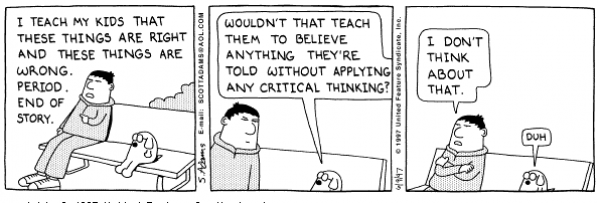Sketch Artists Helps to Catch a Thief
Sketch Artists Helps to Catch a Thief
It appears this story posted by KY3 news is true. Even if it's not, it is still hilarious and helps to further an important topic on "identification" recently started under my navigation label criminal law "defences". In this story, a sketch artist in Lancaster, Pennsylvania helped to apprehend a thief:
Though we certainly don't have all of the evidence available to Lancaster police, it's clear from looking at this sketch artist depiction that the perpetrator of the crime had a nose, mouth, pointy chin, ears, black dotty pupils with no whites of the eyes, hairline hair, a hat and no eyebrows. Cross comparing the sketch with the photo of the perpetrator, it's clear that he -- at the very least - has a nose, mouth, chin, ears and hair. Like the sketch, the perpetrator appears to be white. Case closed!
search for suspect started in the world of dilbert
Based on the artist sketch, I imagine the police started their search for the thief in the world of Dilbert (a depiction of which I have borrowed to illustrate the point):

It appears that after a thorough investigation and aggressive interrogation of Dilbert, his Beagle and his manager, those cagey sleuths in Lancaster managed to make city streets safe again.
critical thinking required: identification must be correct
In all seriousness, identification in criminal cases is no laughing matter. It must be correct. To ensure correctness, comprehensive police investigation is necessary. Part of a good police investigation is to ensure that investigators secure meaningful details so as to permit an independent review. Indeed, critical thinking is important in any criminal case. Before convicting a person of a crime, we should all think critically about whether the accused has been property and correctly identified.
As the Alberta Court of Appeal strenuously encourages in R. v. Atfield:
It is important that investigating police should obtain from each identification witness, as soon as possible after the alleged observation, the fullest description of the person observed, which can be cross-checked with the descriptions given by other witnesses, and with the actual appearance of the person suspected, and with the descriptions given by the witnesses in court. The witnesses should be interviewed independently of each other, if at all possible before they have had the opportunity of communicating, and always without suggestion or assistance. Meticulous notes should be taken of the descriptions obtained.
As Mr. Justice Berger recognized in R. v. Zurowski, there have been many miscarriages of justice based on erroneous eyewitness identification. Examples include David Milgaard, Randy Druken, Thomas Sophonow et al. These miscarriages resulted in innocent people not only being convicted of a serious crime, but in cases such as Milgaard, having to spend decades in jail for a crime not committed. In a court system where eyewitness identification and other identification appears more credible and reliable than it really may be, it is so important that all of us guard against strong biases to favour evidence that amounts to little more than "that is the man".
As outside observers, we might be inclined to think that the Lancaster situation is humorous, yet rare. I suspect many experienced criminal lawyers in Calgary and elsewhere, along with many good prosecutors and erudite judges would confirm that though the Lancaster case appears unique to itself, identification errors jeopardizing potentially innocent people are not rare enough.
David Chow is an Alberta criminal lawyer with his main office in Calgary. If you have been charged with any criminal offence, call 403.452.8018 for a free telephone consultation. David Chow offers affordable rates along with experienced and proven legal representation.
